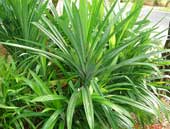 |
| Pandan leaves are used in many Southeast Asian countries to flavour special dishes |
Want to make ordinary rice smell like basmati? A leaf or two from an exotic plant may do the trick. After all, people in many Southeast Asian countries have been using pandan leaves for centuries to flavour their dishes, be it rice, chicken or sweets.
A team of Indian researchers has detected a compound in the leaves of the pandan plant (Pandanus amaryllifolius) which imparts an aroma to rice varieties such as basmati and jasmine. This is 2-acetyle-1-pyrroline or 2AP, the most important of the nearly 100 volatile compounds found in basmati. Significantly, pandan contains 10 times more 2AP than the best basmati.
The scientists, led by Altafhusain Nadaf of the University of Pune and Sellappan Krishnan of Goa University, found that 2AP is stored on the underside of pandan leaves in special structures called “epidermal papillae”. They reported their work in the July 25 issue of the journal Current Science.
Popular and abundantly grown in countries such as Thailand, Vietnam and Indonesia, pandan is available in India too. But the plants found on the east and west coasts appear to have a higher 2AP content than those growing in other regions. Nadaf is currently on the job to spot the Indian pandan variety that has the highest 2AP content.
The next logical step for the scientists would be to figure out why pandan leaves have such a high concentration of the naturally occurring chemical compound. “Understanding this would help us breed basmati varieties with better grain aroma and perhaps even turn non-scented types to scented ones,” says Nadaf.
But while identifying the genes responsible for 2AP would be vital, Krishnan doesn’t think this can actually lead to a genetically modified basmati variety with better fragrance. “From what we already know, 2AP is not synthesised by a single gene but a cluster of them. Transferring a number of genes for obtaining a particular trait through genetic modification is next to impossible using the methods currently available,” he observes.
Interestingly, pandan has been a focus of research for scientists at Calcutta’s Bose Institute too. A few years ago, botanists from the institute — along with those at Chiang Mai University in Thailand — developed a tissue culture protocol for mass cultivation of the plant without affecting its ability to produce higher 2AP content.
Pandan leaves are mostly added to ordinary rice to simulate the flavour of Thai jasmine rice, one of the world’s best aromatic rice cultivars. They are also used as fragrant wrappers for grilled chicken or yam jam.











